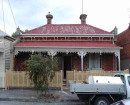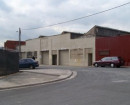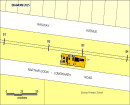FORMER BENDIGO SANITARY DEPOT
2-10 PIPER LANE, EAST BENDIGO, VIC
-
Add to tour
You must log in to do that.
-
Share
-
Shortlist place
You must log in to do that.
- Download report
Statement of Significance
-
-
FORMER BENDIGO SANITARY DEPOT - History
SiteCard data copied on 25/09/2025:The property at 2–10 Piper Lane is currently vacant Crown land, under settlement for purchase by HADOH Pty Ltd from the Victorian Government. No visible surface remains of former buildings were identified during the Cultural Heritage Management Plan (CHMP) survey. However, analysis of historical aerial imagery reveals that structures once stood further west on the property, with smaller outbuildings located near the historical artefact scatter identified. These buildings were demolished between 1958 and 1967. Historical records held at the Public Record Office Victoria (PROV) identify these structures as the former Bendigo Sanitary Depot buildings associated with the Bendigo Sewage Farm and Manure Depot—also known as the Wellsford Sanitation Depot—which was officially gazetted in 1892. The land at Piper Lane formed a small portion of the original 127-acre depot site, which was expanded by an additional 227 acres in 1894. A detailed account published in the Bendigo Independent in December 1913 described the depot as a well-managed and impressively hygienic facility located approximately 2.5 miles (4 kilometres) from the city centre. During an unannounced inspection, City Health Inspector J.E. Paynter guided a local journalist through the site, showcasing its operations in full swing. Nightsoil pans were unloaded onto a sturdy wooden platform and transferred into vans, while workers scrubbed pans and wagons with Condy’s fluid and phenyle. The air was dominated by disinfectant scents, with no offensive odours detected. In one corner, a worker treated disease-contaminated pans by dipping them into boiling tar, while a copper cauldron bubbled nearby. Adjacent to this was a blacksmith and repair shop where damaged pans were repaired and lids refitted with rubber seals to ensure airtight transport. The depot also housed stables for approximately two dozen draught horses and a fleet of clean wagons, all prepared for daily collection. Waste was transported across a large paddock to trenches located roughly half a mile (805 metres) away. Each trench received about 12 inches (30 centimetres) of waste material from a trough before being filled in with soil. The trenching system was rotational, with older trenches covered and dry, and some areas showing lush grass growth—evidence of soil enrichment. The reporter noted minimal surface liquid and no abnormal smells, even in freshly opened trenches. Inspector Paynter was commended for his methodical leadership and rapport with workers. He advocated for daytime collection, arguing it allowed for cleaner, more thorough service and reduced inconvenience for residents. The article concluded with a strong endorsement of the depot’s operations, portraying it as a model of early 20th-century sanitation infrastructure—efficient, hygienic, and professionally run. In the 1940s, the site was considered for development as the future Bendigo Aerodrome. Despite this proposal, the sanitation depot continued operations treating nightsoil and receiving trade refuse, well into the 1950s and possibly the 1960s. Following the demolition of depot structures, the land has been used as open space or for grazing, likely supporting pastoral or light agricultural activities. Two historical mine shafts (Mine IDs: 208994 and 208989) are located directly west of the property, adjacent to Spring Gully Channel. Further research into the site’s earlier land use is ongoing. To date, no records have been found predating 1892, aside from its inclusion in the Barnedown West pastoral run.FORMER BENDIGO SANITARY DEPOT - Interpretation of Site
The archaeological evidence identified during the survey indicates that the site retains a modest yet meaningful record of historical occupation and activity. While surface finds across most of the property were sparse—primarily comprising historical ceramics and glass—a concentrated artefact scatter (n= > 50) was documented at the location marked on the attached map. The potential extent of the historical site has been delineated with a yellow line on this map, based on on-site observations. However, further archaeological investigation would be required to clarify the full extent of the artefact scatter. The historical artefact scatter included complete glass bottles, leather shoes, metal fragments, bricks and brick fragments, glass and ceramic fragments. Some items had been recently repositioned on or within a nearby dead tree trunk, suggesting modern interference unrelated to the original depositional context. Preliminary dating of the artefacts places them approximately between the late 1800s and early 1900s, consistent with the site's historical use as a Sewage Farm and Sanitary Depot dating to 1892. Although no surface structural remains were observed during the field survey, historical aerial imagery confirms that buildings once stood west of the artefact concentration, with smaller outbuildings likely nearby. These structures were demolished between 1958 and 1967, and their absence aligns with the site’s current open and undeveloped condition. Following demolition, the land appears to have been used for grazing or light agricultural purposes. These activities may have contributed to the dispersal or degradation of archaeological materials, particularly in areas affected by trampling, erosion, or vegetation clearance. Nonetheless, the survival of a concentrated artefact scatter suggests that subsurface integrity may persist in less disturbed areas. In summary, the artefact scatter likely reflects domestic or occupational activity associated with now-demolished structures—potentially outbuildings or workspaces linked to the former Bendigo Sanitary Depot. Alternatively, the assemblage may represent refuse disposal practices concurrent with nightsoil treatment, which was historically ploughed into the land.
Heritage Inventory Description
FORMER BENDIGO SANITARY DEPOT - Heritage Inventory Description
The majority of the property contained only sparse historical ceramics and glass, however a concentrated scatter of artefacts (n= >50) at the location marked in the attached map was noted. This area contained a dense surface scatter, with items such as complete bottles, leather shoes, metal fragments, brick/brick fragments, glass and ceramics. Notably, several artefacts had also been recently placed inside and on top of a nearby dead tree trunk. This appears to have been done recently. Based on a preliminary assessment, the artefacts may date from the late 1800s to early 1900s.
-
-
-
-
-
SWAN HILL WATER TOWER
 Victorian Heritage Register H2452
Victorian Heritage Register H2452 -
RULES OF THE MELBOURNE FOOTBALL CLUB
 Victorian Heritage Register H2428
Victorian Heritage Register H2428 -
MOUNT LITTLE DICK FIRE TOWER
 Victorian Heritage Register H2461
Victorian Heritage Register H2461
-
-









